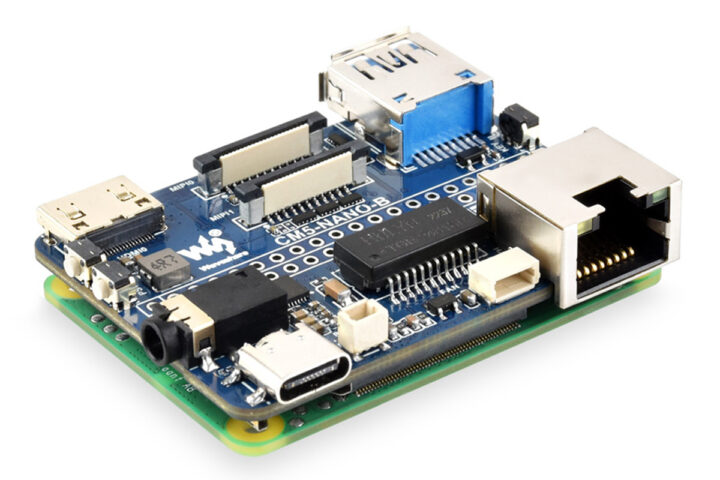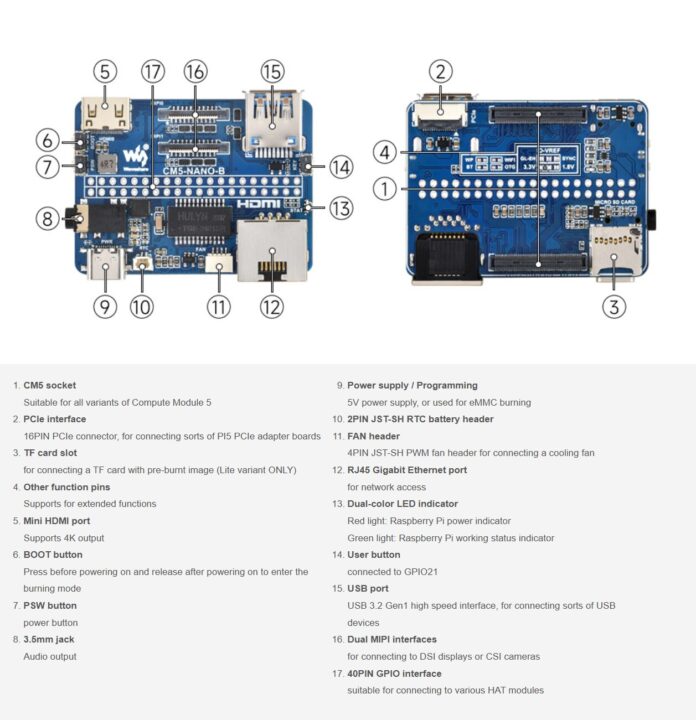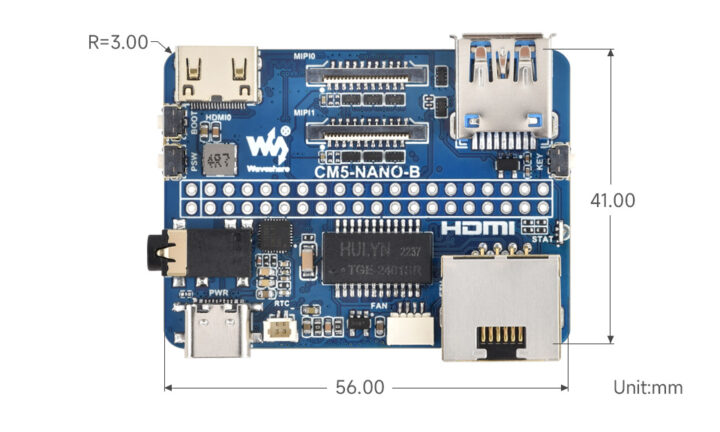Waveshare has just released the CM5-NANO-B, a compact Raspberry Pi CM5 carrier board, with the same dimensions as the Compute Module 5 and multiple peripheral interfaces making it suitable for industrial automation, IoT, embedded computing, AI development, and other space-constrained applications.
Key features include a Gigabit Ethernet RJ45 port, an unpopulated 40-pin Raspberry Pi GPIO header, a USB 3.2 Gen1 Type-A port, dual MIPI 4-lane interfaces, a mini HDMI port supporting 4K output, a USB audio 3.5mm jack, a microSD card slot, and a 16-pin PCIe Gen2/3 x1 connector. Power is supplied via a USB-C port (5V/5A), and additional features include an RTC battery header, a 4-pin PWM fan header, a dual-color LED indicator, and user-configurable buttons.

Waveshare CM5-NANO-B specifications:
- Compatibility – Raspberry Pi Compute Module 5 (CM5)
- Storage – MicroSD card slot (for Raspberry Pi CM5 Lite)
- Display
- Mini HDMI output up to 4K resolution
- Up to 2x MIPI DSI interfaces (multiplexed with MIPI CSI)
- Camera – Up to 2x MIPI CSI interfaces (multiplexed with MIPI DSI)
- Audio – 3.5mm audio jack
- USB
- 1x USB 3.0 Type-A port
- 1x USB 2.0 Type-C port for power and data (e.g. flash the eMMC)
- Networking
- Gigabit Ethernet
- Optional WiFi 5 and Bluetooth 5.0 on Raspberry Pi CM5
- Expansion
- PCIe Gen2/3 x1 connector
- 40-pin GPIO header with I2C, UART, etc…
- Misc
- BOOT and PSW (power) buttons
- User button
- 4-pin JST-SH PWM fan header
- RTC battery header
- Dual-color LED indicator
- Red – Raspberry Pi power indicator
- Green – Raspberry Pi working status indicator
- Power Supply – 5V/5A via USB-C
- Dimensions – 56 x 41 mm (about the same as the Raspberry Pi CM5)
- Operating Temperature – -20°C to 85°C
The Waveshare CM5-NANO-B supports MIPI CSI cameras, including OV9281, IMX290, IMX327, IMX378, IMX219, IMX477, and IMX708. Camera modules are configured via dtoverlay settings in /boot/firmware/config.txt, with cam0 and cam1 designations for dual-camera support. The board allows one DSI display and one CSI camera connection simultaneously, e.g., an IMX219 camera on MIPI1 and a DSI display on MIPI0. You can check out the waveshare wiki page for more information and this configuration is also similar to the Raspberry Pi CM5 IO Board.
It’s not the first Raspberry Pi Compute Module 5 carrier board from Waveshare, as the company previously introduced the CM5-PoE-BASE-A, and Pineboards Modulo5 IO PoE+ Carrier Board is another option besides the official IO board. However, the CM5-NANO-B is the most compact Raspberry Pi CM5 carrier board we’ve seen so far.
The CM5-NANO-B Raspberry Pi CM5 carrier board costs around $22.94 on Aliexpress and $26.99 on Amazon, and you’ll also find it on Waveshare for $17.99 plus shipping.
Debashis Das is a technical content writer and embedded engineer with over five years of experience in the industry. With expertise in Embedded C, PCB Design, and SEO optimization, he effectively blends difficult technical topics with clear communication
Support CNX Software! Donate via cryptocurrencies, become a Patron on Patreon, or purchase goods on Amazon or Aliexpress. We also use affiliate links in articles to earn commissions if you make a purchase after clicking on those links.






I like the size but I wonder how the cpu could be cooled sufficiently in this form factor
The board still supports the official heatsink or EDATEC active cooler:
https://www.cnx-software.com/2024/12/22/raspberry-pi-cm5-review-different-cooling-solutions/
It’s on the other side, so I don’t see the problem.
I have the CM4 variant of the board and a big heatsink as the size of the cm is enough to keep it below 60’C.
I’ve printed a 3d case and using it for kodi (libreelec)
LibreELEC:~ # vcgencmd measure_temp
Two big mistakes here:
Otherwise, I like the idea.
• What? This critique makes non sense. A regular Pi 5 has 3 sides populated but that has not prevented its usefulness. This board provides almost all the same features PLUS extra buttons in a SMALLER area, but is somehow expected to magically use less edge space? Plus one of the sides being occupied is actually a single user-defined button, so it does nothing unless manually tied to some action. Simply don’t activate the button then if it will interfere. If that tiny button is really such a bother, it takes 2 seconds to snip it off. There, now only 3 sides are being used, just like the Pi.
• The CM5 has the mount holes. Screw that into whatever location desired. Then snap the Waveshare board on top. If you like, use a couple of .01€ zip ties for extra security. This is an engineering exercise, not some impossible theoretical quantum physics.
No, Luc is right, the space taken by a board is not just the size of the board, but the size taken by all cables around that you can not always fully bend. Here, there is no front nor back. If you put it in a rack, presumably you will connect the power via the USB-C on the same side as the RJ45 which we’ll call “the back”, then you have the HDMI connector on the front that forces you to make a loop with the cable to go back into the rack. You’ll hardly place more than one or two on a single plate in a rack just due to the space taken by the cables. And speaking about RPi, that’s definitely *not* a model of high-density board either! What a pain to have them in a rack! There’s a reason why Nano-ITX and Pico-ITX are quite popular when seeking high density. Sometimes you can even place them vertically next to each other because most of the time, only one side is used.
Now that doesn’t void the benefits of this device at all, it’s just that once connected it can take lots more room than other apparently larger solutions.
I believe the WaveShare purchase link is wrong (points to the CM4 board), the correct one is this: https://www.waveshare.com/product/raspberry-pi/cm5-nano-b.htm
Amazon link is wrong, too. Someone got a bit sloppy with this article…